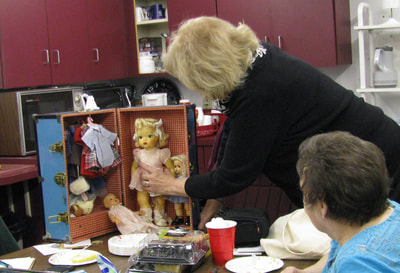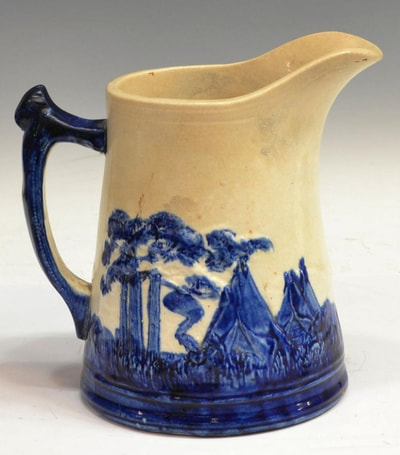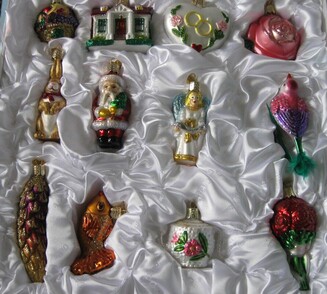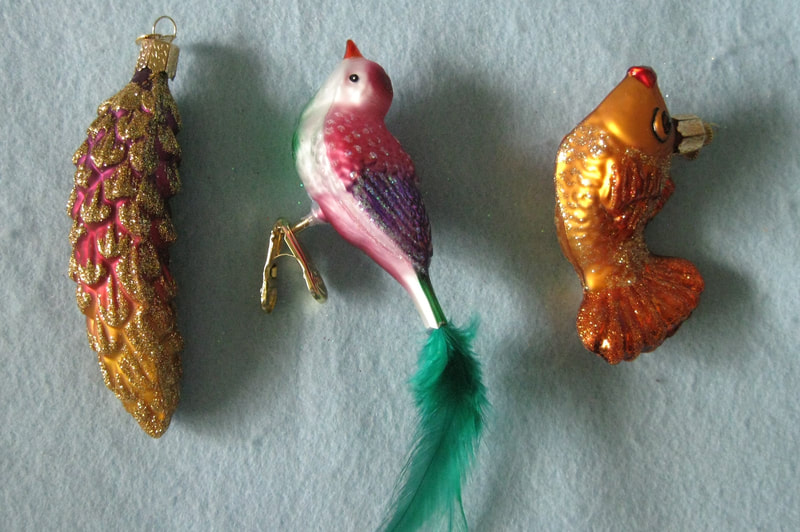The Friday Morning Antiques Study Group began in 1973 at the hands of Jane Johnson, who is a long-time resident of North Platte. Jane fostered her love of antiques by assembling a group of friends with like interests and meeting each month. Their meetings consisted of breakfast at homes of members, a show and tell by the hostess about her favorite antique item or collection, and lots of discussion.
When Jane heard about The Questers, she thought, "This is just perfect for our group." She ordered information about forming a Quester chapter, offered the information to her friends and on June 16, 1982, Prairie Treasures #1018 was officially born. Throughout the years, we have had many fascinating programs, visited historic places, and completed service projects in our city and surrounding area. We are always looking for new members and welcome visitors at our meetings. We meet on the 2nd Friday each month at 10:00 a.m. For more information about us, please leave a message on the Contact Us page.
When Jane heard about The Questers, she thought, "This is just perfect for our group." She ordered information about forming a Quester chapter, offered the information to her friends and on June 16, 1982, Prairie Treasures #1018 was officially born. Throughout the years, we have had many fascinating programs, visited historic places, and completed service projects in our city and surrounding area. We are always looking for new members and welcome visitors at our meetings. We meet on the 2nd Friday each month at 10:00 a.m. For more information about us, please leave a message on the Contact Us page.
|
Members of Prairie Treasures Questers Chapter #1018 in North Platte recently visited the Robert Henri Museum in Cozad, Nebraska and noticed that the large dining room was lacking some furnishings. They shopped around and found an exquisite set of antique china, silverware, and candlesticks to add to the lovely old table in the room. The Belmont China is one of the earliest patterns by Johnson Brothers China, that began operation in England in 1880. Stratford Silverplate Special 1924 Shakespeare pattern silverware is the perfect accent and Jeanette Glass Company Iris and Herringbone Candlesticks from 1928 add sparkle to the beautiful floral arrangement by Sharon. (See the complete story on the "News" page.)
|
|
|
|
It's beginning to look a lot like Christmas! We visited a beautiful little holiday gift shop in Eustis, Nebraska. Monika and Jan immigrated to Cozad, Nebraska years ago and married men from Eustis, a farming community made up of German families. Every year, they return to Germany to visit their families and shop for the special products in their store. It is just like walking into Christmas day! The selection is always wonderful and these ladies make everyone feel so welcome. |
|
We also visited "The Santa Lady." Nancy is a retired teacher and horse lover who has the largest collection of Santas anywhere. It is somewhere in the neighborhood of 9,000. Yes, she does have a favorite. Every Santa in the collection has its own story and you would need several hours to visit each one. Thank you, Nancy for opening your lovely home to us and letting us enjoy all your Santas. |
|

In November, our meeting program was "Hobo Signs & Symbols". We learned that the Hobos were not Bums, because Hobos wanted to work to support themselves and their families, whereas Bums would not work at all. Hobos developed a language of symbols and left signs for other Hobos to help them find the things they needed for survival. Many men became Hobos at the end of the Civil War because they had no way to get home when they were dismissed from service. The railroad systems provided a free way to travel so they could search for employment.
|
Sandy, our State President, honored us with a visit at our February, 2018 chapter meeting. She brought her Terry Lee doll collection and explained the difference between the antique version and today's version. Although the facial expression and clothing are very similar on both versions, the skin tone makes knowing old from new easy. We all had so much fun visiting with Sandy. Thank you for coming to our meeting, Sandy.
|
|
Halloween History and Traditions
Members of Prairie Treasures Chapter #1018 were treated to an excellent program by Sharon about Halloween, a world-wide annual celebration. Although celebrations vary by country, they are popular everywhere and have their roots in Celtic traditions nearly 1500 years ago. Irish immigrants brought Halloween to America in the 1800s and it has since evolved from a day to honor dead ancestors to a happy day of costume parties and sweet treats enjoyed by children as well as adults. |
|
|
Sleepy Eye Pottery Recently, Prairie Treasures Chapter #1018 was treated to a fascinating program by Teresa about this unique pottery. Sleepy Eye Flour Mill in Minnesota inserted many of these pieces in their bags of flour as premiums. “Old Sleepy Eye” (Tahtahumba, which means eyelids drooping) was a chief of the Lower Sisseton Sioux from 1822 to 1825. The flour mill took his likeness as their trademark and used it on many types of advertising from the 1890’s to 1937. Although these items are becoming quite rare, most commonly found are the heavy gray and blue stoneware items manufactured by the Western Stoneware Company. Subsequent runs of this pottery included blue and white items, green and yellow, brown and yellow, and brown and white. Also available were items in colors of all cobalt, all green, and all brown. |
|
According to tradition in Germany, this Bride's Box is given to a newlywed couple to ensure happiness for their life together as husband and wife. It is usually given to the bride before the wedding at her bridal shower. This set was designed and manufactured by an old German family named Merkz. Their business has existed since the 1800s. Each ornament is delicately created with molten hand-blown glass into a hand-crafted mold, where the inside of each is coated with a hot solution of silver. Then, after they are removed from the mold, they are hand painted and glittered in a series of labor intensive steps to achieve the most beautiful creations possible. Each ornament in the set has special meaning; The Flower Basket = Good Wishes, The House = Shelter and Protection, The Santa = Unselfishness and Goodwill, The Angel = God's Guidance in the home, The Rose = Beauty and Affection, The Rabbit = Hope and Faith, The Pinecone = Motherhood and Fruitfulness, The Bird = Happiness and Joy, The Fish = God's Blessings, The Teapot = Hospitality, The Fruit Basket = Generosity, and The Heart = True Love. |
Pictures in the Header
The first picture in the top row of the Header is of The Fort Cody Trading Post. From the outside, it looks like a frontier log stockade with authentically dressed mannequins with toy rifles standing guard. Inside it's a combination gift shop and museum, with authentic Buffalo Bill and Wild West memorabilia, plus a hand carved miniature mechanized Wild West Show made of 20,000 parts. A taxidermy two-headed calf and frontier cannons are among the other curiosities to be seen. Find jewelry, moccasins, and coonskin caps among many other gifts to take home, too.
The second picture in the top row of the Header is of the world's largest reclassification rail yard. Thousands of rail cars travel through here every day to be reclassified and rerouted on their way. North Platte's history is tied to the Union Pacific Railroad from its beginning. The rail yard once contained a "round house" repair facility that also provided shelter to citizens during Indian attacks. Many new citizens came here on trains and to this day, the Union Pacific Railroad is the largest employer here.
The third picture in the top row of the Header is of Buffalo Bill's 1880s Victorian house located in Buffalo Bill Ranch State Historical Park. The property also has a horse barn and outbuildings of Cody's famous Scout's Rest Ranch. The site features Wild West Show memorabilia, period household furnishings, picnic areas and walking trails. On April 11, 1944, the Paramount Theater in North Platte hosted the world premier of the technicolor movie "Buffalo Bill." The amazing story of the Indian fighter and scout who made North Platte his home for many years was brought to the screen with Joel McCrea taking the part of Buffalo Bill. Featured actors were Maureen O'Hara, Linda Darnell, Thomas Mitchell, Edgar Buchanan, Anthony Quinn and many others.
The first picture in the bottom row of the Header shows a bucking bronc rider at the Buffalo Bill Rodeo during Nebraskaland Days. This rodeo stems from Buffalo Bill's activities in our area and draws cowboys and cowgirls from all over the United States and Canada. Complete with a Miss Rodeo America competition, the rodeo is an exciting and very popular attraction during the month of June.
The second picture in the bottom row of the Header is of the Golden Spike Tower and Visitor Center west of North Platte. It provides a birds-eye view of Union Pacific's massive Bailey Yard. In 1995, the Guinness Book of World Records recognized the Bailey Yard as the world's largest railroad classification yard. It has since grown by 25 percent. It stretches eight miles and covers nearly 3000 acres.
The third picture in the bottom row shows a Wild West stagecoach and horses coming to the Buffalo Bill Rodeo. Apart from being transportation for old west citizens, stagecoaches also transported mail, supplies, and many other things. They are now popularly showcased items in rodeos and parades.
.
The first picture in the top row of the Header is of The Fort Cody Trading Post. From the outside, it looks like a frontier log stockade with authentically dressed mannequins with toy rifles standing guard. Inside it's a combination gift shop and museum, with authentic Buffalo Bill and Wild West memorabilia, plus a hand carved miniature mechanized Wild West Show made of 20,000 parts. A taxidermy two-headed calf and frontier cannons are among the other curiosities to be seen. Find jewelry, moccasins, and coonskin caps among many other gifts to take home, too.
The second picture in the top row of the Header is of the world's largest reclassification rail yard. Thousands of rail cars travel through here every day to be reclassified and rerouted on their way. North Platte's history is tied to the Union Pacific Railroad from its beginning. The rail yard once contained a "round house" repair facility that also provided shelter to citizens during Indian attacks. Many new citizens came here on trains and to this day, the Union Pacific Railroad is the largest employer here.
The third picture in the top row of the Header is of Buffalo Bill's 1880s Victorian house located in Buffalo Bill Ranch State Historical Park. The property also has a horse barn and outbuildings of Cody's famous Scout's Rest Ranch. The site features Wild West Show memorabilia, period household furnishings, picnic areas and walking trails. On April 11, 1944, the Paramount Theater in North Platte hosted the world premier of the technicolor movie "Buffalo Bill." The amazing story of the Indian fighter and scout who made North Platte his home for many years was brought to the screen with Joel McCrea taking the part of Buffalo Bill. Featured actors were Maureen O'Hara, Linda Darnell, Thomas Mitchell, Edgar Buchanan, Anthony Quinn and many others.
The first picture in the bottom row of the Header shows a bucking bronc rider at the Buffalo Bill Rodeo during Nebraskaland Days. This rodeo stems from Buffalo Bill's activities in our area and draws cowboys and cowgirls from all over the United States and Canada. Complete with a Miss Rodeo America competition, the rodeo is an exciting and very popular attraction during the month of June.
The second picture in the bottom row of the Header is of the Golden Spike Tower and Visitor Center west of North Platte. It provides a birds-eye view of Union Pacific's massive Bailey Yard. In 1995, the Guinness Book of World Records recognized the Bailey Yard as the world's largest railroad classification yard. It has since grown by 25 percent. It stretches eight miles and covers nearly 3000 acres.
The third picture in the bottom row shows a Wild West stagecoach and horses coming to the Buffalo Bill Rodeo. Apart from being transportation for old west citizens, stagecoaches also transported mail, supplies, and many other things. They are now popularly showcased items in rodeos and parades.
.















